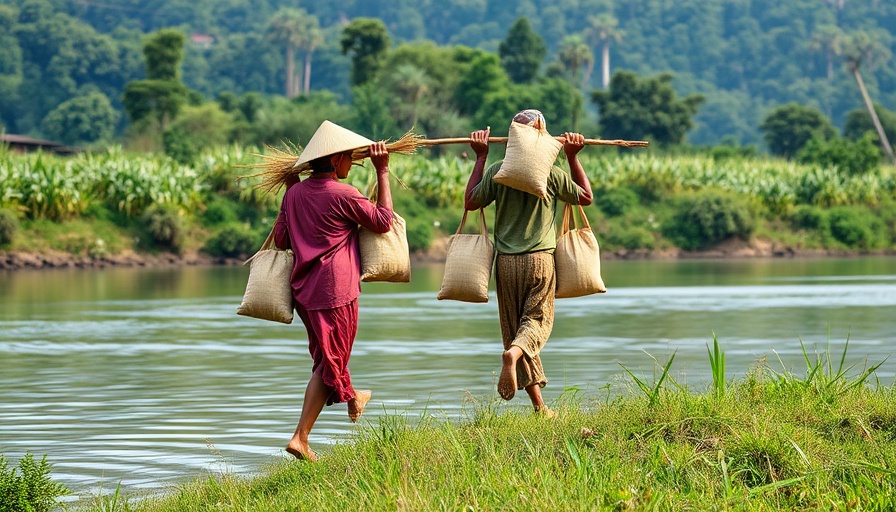
Dhaka's Vanishing Green Spaces: An Urgent Call to Action
As a fervent sun beats down on Bangladesh’s capital, Dhaka, the voices of hundreds rise in unison during a sit-in that has now spanned over 137 days. Their goal? To protect one of the city’s last remaining green oases, Panthakunja Park, from the impending destruction caused by a new elevated expressway project. This initiative is emblematic of a larger, troubling trend: the rapid shrinkage of green spaces in Dhaka, which have plummeted from 17% in 1989 to an alarming 2% in 2020. While urbanization is often seen as a sign of development, for the citizens of Dhaka, it has become a stark reminder of lost opportunities for sustainability and ecological balance.
The Raw Reality of Urbanization
Under the pressure of a burgeoning population and expansive urban growth, the lush biodiverse environments that once flourished in Dhaka are disappearing. As reported by Amirul Rajiv, a lead coordinator with the Bangladesh Tree Protection Movement, the desecration of Panthakunja Park began on a December morning when activists discovered truckloads of felled trees—habitats for countless birds and animals—being carted away without warning. Rajiv recounted how the legacy of this park, teeming with urban wildlife, has now turned into a graveyard of tree stumps, depriving not just the ecosystem but the very community that relied on this green space for shade and solace.
Rising Temperatures and the Climate Crisis
The impact of losing these vital green spaces extends beyond the emotional loss felt by activists like Rajiv. The worsening climate crisis, in a country already vulnerable to climate impacts such as rising temperatures and erratic rainfall, makes these green areas crucial for combating heat and fostering biodiversity. As a result, the sit-in serves as both a protest and a poignant reminder of the consequences of neglecting environmental conservation amidst urban development.
The Role of Activism in Urban Ecology
The sit-in at Panthakunja Park has successfully mobilized community activists, artists, and citizens who care deeply about sustainability in their urban spaces. Through rapid digital communication platforms like WhatsApp, a network of environmentally conscious citizens has risen to challenge the rapid urbanization threatening their city’s natural heritage. This grassroots activism not only highlights the need for sustainable development, but also compels local authorities and developers to consider the ecological consequences of their actions.
Park Restoration: A Promise or a Threat?
Despite assurances from the Chinese investors behind the expressway project that they will restore the park after construction, activists remain skeptical. The risk of irreparable harm outweighs promises made. Skepticism around redevelopment projects transpires frequently in rapidly urbanizing areas. As many echo Rajiv’s sentiments, the question arises: can true restoration ever take place if the ecological damage already inflicted is significant?
Taking Sustainable Action: The Path Forward
What can individuals do in the fight for Dhaka’s green future? The demands of the sit-in go beyond protecting a single park; they challenge everyone to reconsider their role in environmental stewardship. Acting on behalf of endangered spaces means being aware of sustainable practices, supporting green initiatives, and participating in community work that prioritizes ecological well-being.
It's about pushing for sustainable cities where urban development and green spaces can coexist harmoniously. Educational efforts focused on reducing one’s ecological footprint, supporting sustainable products, and engaging in community gardening can foster a new wave of environmental consciousness.
In Conclusion: Stand Up for Sustainability
The significance of preserving Panthakunja Park goes far beyond aesthetics; it symbolizes the intrinsic relationship between urban development and environmental conservation. As the climate crisis looms large, ensuring the existence of green spaces is not merely a matter of preference, but of survival essential for the community's ecological health.
Join the movement for sustainable living! Engage in local conservation programs, support environmentally responsible businesses, and voice your concerns to policymakers. Your participation can help reshape the future of Dhaka's ecology for generations to come.
 Add Row
Add Row  Add
Add 



Write A Comment